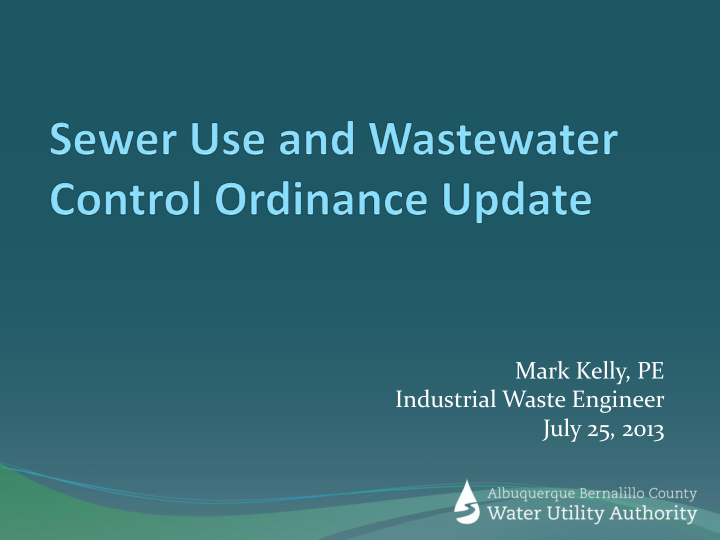



Mark Kelly, PE Industrial Waste Engineer July 25, 2013
What is The Sewer Use and Wastewater Control Ordinance? Sets requirements for sanitary sewer users Regulates the discharge of pollutants into the collection system Enables the Water Authority to achieve compliance with U.S. EPA National Pollutant Discharge Elimination System (NPDES) and Southside Water Reclamation Plant (SWRP) effluent and sludge limits.
Limitations on Sludge Disposal Injury to Workers Options and/or from Hazardous Greater Fumes Expense Corrosion of Collection System and/or Treatment Plant Explosions Interference with Wastewater Pass-Through of Treatment Facility Toxics into Surface Waters
Why a new Ordinance? A requirement of the new U.S. EPA National Pollutant Discharge Elimination System (NPDES) permit for SWRP
What will be changed? Fats, Oils, and Grease Policy created Sewer Use and Wastewater Control Ordinance updated to match EPA model Technically Based Local Limits updated Enforcement Response Plan updated
Ordinance Process EPA MODEL PRETREATMENT ORDINANCE Office of Wastewater Management/Permits Division http://www.epa.gov/npdes/pubs/pretreatment_model_suo.pdf Reviewed 40 CFR 403 Pretreatment regulations Reviewed other Publicly Owned Treatment Works (POTWs) Pretreatment Ordinances
Ordinance Process Draft Ordinance Public Participation Meetings Ordinance, ERP, FOG Policy posted online Incorporation of Comments Submitted to EPA by October 1, 2013 EPA has comments or gives certificate of approvability Ordinance posted publicly for one month Water Authority Board approves and incorporates new ordinance
Ordinance Requirement: Fats, Oil and Grease (FOG) Capacity, Management Operations, and Maintenance (CMOM) Plan with an emphasis on FOG Policy FOG policy is a re-evaluation of the existing Ordinance Grease Removal System (GRS) Requirements Maintenance Inspections Record Keeping Best Management Practices (BMPs) 8
Changes From The Previous Ordinance: Fats, Oil and Grease Maintenance: Minimum cleaning every 6 months 25% rule 9
FOG Policy: Pumper Requirements Must use a pumper that is in compliance Complete Evacuation All chambers must be pumped No decanting or discharging of wastewater back into trap Manifests Must be provided Date, time, volume, condition Prohibitions Discharging of unprocessed GRS waste at SWRP Blending 10
Changes From The Previous Ordinance: Dental Amalgam Separators Incorporated into the ordinance Exemption expanded for not greater than three amalgams per 12 months Best Management Practices 11
Ordinance Requirement: Industrial Permits Various Industrial Permit Changes: Appeal Process Transfer of permits is possible Permit submittals based upon postmark
Ordinance Requirement: Industrial Permits Cease and desist orders clarified Administrative Assessments: power to assess at least $1,000.00 per violation per day Is spelled out in Rate Ordinance passed 6/19/13 http://www.abcwua.org/Legislation___Ordinances.aspx
Ordinance Requirement: Technically Based Local Limits (TBLLs) For specified pollutants: Domestic manhole, industrial discharge, and plant influent water quality results determine SWRP loading Plant influent and effluent water quality results determine SWRP removal efficiency Plant influent loading compared with NPDES effluent limits and sludge disposal limits If an influent loading is too high, local limits change
Ordinance Requirement: Parameter Removal % Aluminum 92% Technically Based Ammonia 98% Arsenic 43% Local Limits (TBLLs) Boron 36% Cadmium 87% Chromium 95% COD 91% Removal Efficiencies CBOD 97% Copper 89% Cyanide 67% Fluoride 6.1% Lead 92% Mercury 97% Molybdenum 79% Nickel 62% Selenium 60% Silver 92% TSS 97% Zinc 90%
Ordinance Requirement: Analyte Conc. (mg/L) Aluminum 0.710 Technically Based Ammonia 33.6 Arsenic 0.0041 Local Limits (TBLLs) Boron 0.473 Cadmium 0.0001 Chromium 0.0023 COD 547 Domestic Manhole Copper 0.043 Concentrations Fluoride 0.690 Lead 0.0017 Mercury 0.000168 Molybdenum 0.013 Nickel 0.020 Selenium 0.0016 Silver 0.0016 TSS 258 Zinc 0.399
Ordinance Requirement: Technically Based Local Limits (TBLLs) 2013 TBLL, 2013 TBLL, Previous TBLL, Daily Maximum Monthly Average Pollutant mg/l Criteria Basis Comments Composite mg/l mg/l (unless noted) (unless noted) (unless noted) Aluminum 900 900 Chronic WQS No Change Ammonia None 350.5 103.8 NPDES Permit Limits New Limit Arsenic 0.051 0.051 Digester Inhibition No Change Boron None 699 Irrigation WQS New Limit Cadmium 0.5 0.5 Chronic WQS No Change Chromium 4.1 4.1 Digester Inhibition No Change COD None 5,139 NPDES Permit Monthly Limit New Limit CBOD None 2,107 NPDES Permit Monthly Limit New Limit Copper 5.3 3.2 Digester Inhibition Lower Limit Cyanide 0.45 0.45 Digester Inhibition No Change Fluoride 36 24.7 9.3 Acute/Chronic WQS (Isleta Pueblo) Lower Limits Lead 1 1 0.92 Acute/Chronic WQS Lower Monthly Av. Limit Mercury 0.004 0.004 0.0015 NPDES Permit Limits Lower Monthly Av. Limit Molybdenum 2 2 1.2 Isleta Chronic WQS Lower Monthly Av. Limit
Ordinance Requirement: Technically Based Local Limits (TBLLs) 2013 TBLL, 2013 TBLL, Previous TBLL, Daily Maximum Monthly Average Pollutant mg/l Criteria Basis Comments Composite mg/l mg/l (unless noted) (unless noted) (unless noted) Nickel 2 2 Digester Inhibition No Change Selenium 0.46 0.25 0.04 NM Acute/ Isleta Wildlife WQS Lower Limits Silver 5 5 Acute WQS No Change TSS None 5514 NPDES Permit Monthly Limit New Limit Zinc 2.2 2.2 Nitrification Inhibition No Change Formaldehyde 100 100 Safety No Change TPH 100 100 Safety No Change Oil and 300 100 Operations Lower Limit Grease Phenolic 2 2 Safety No Change TTO 3.2 None CFR Categorical Limit Removed Benzene 0.05 0.05 Safety No Change BTEX 0.75 0.75 Safety No Change 5.0-12.0 s.u. 1 pH 5.0-11.5 s.u. Corrosion Higher Upper Limit 140° F 1 Temperature 140 °F Safety No Change
Changes From The Previous Ordinance: Enforcement Response Plan (ERP) Reimbursement of all Water Authority monitoring costs for samples in violation Administrative Assessments for each discharge violation All citations changed to Administrative Assessments Online: http://www.abcwua.org/Industrial_Pretreatment.aspx
Changes From The Previous Ordinance: Enforcement Response Plan (ERP) Discharge Violations Current AA Proposed AA 100% <Result<120% of Limit $50.00 121% <Result<150% of Limit $100.00 $75.00 151% <Result<200% of Limit $200.00 $100.00 201% <Result<500% of Limit $300.00 >501% of Limit $500 AA $300.00 $500.00 AA doubles after missing RTC sampling Reporting Violations Current Proposed Grace Period 30 days 5 days First occurrence, AA $100.00 $200.00 Subsequent occurrence, AA $200.00 $400.00
Other Changes Wastewater Operator Certification Level III Required for monitoring technicians. Title of Industrial Waste Engineer has been changed to Industrial Pretreatment Engineer.
Comments Due by August 16, 2013 Website: http://www.abcwua.org/Industrial_Pretreatment.aspx Comment Cards pretreatment@abcwua.org
Recommend
More recommend